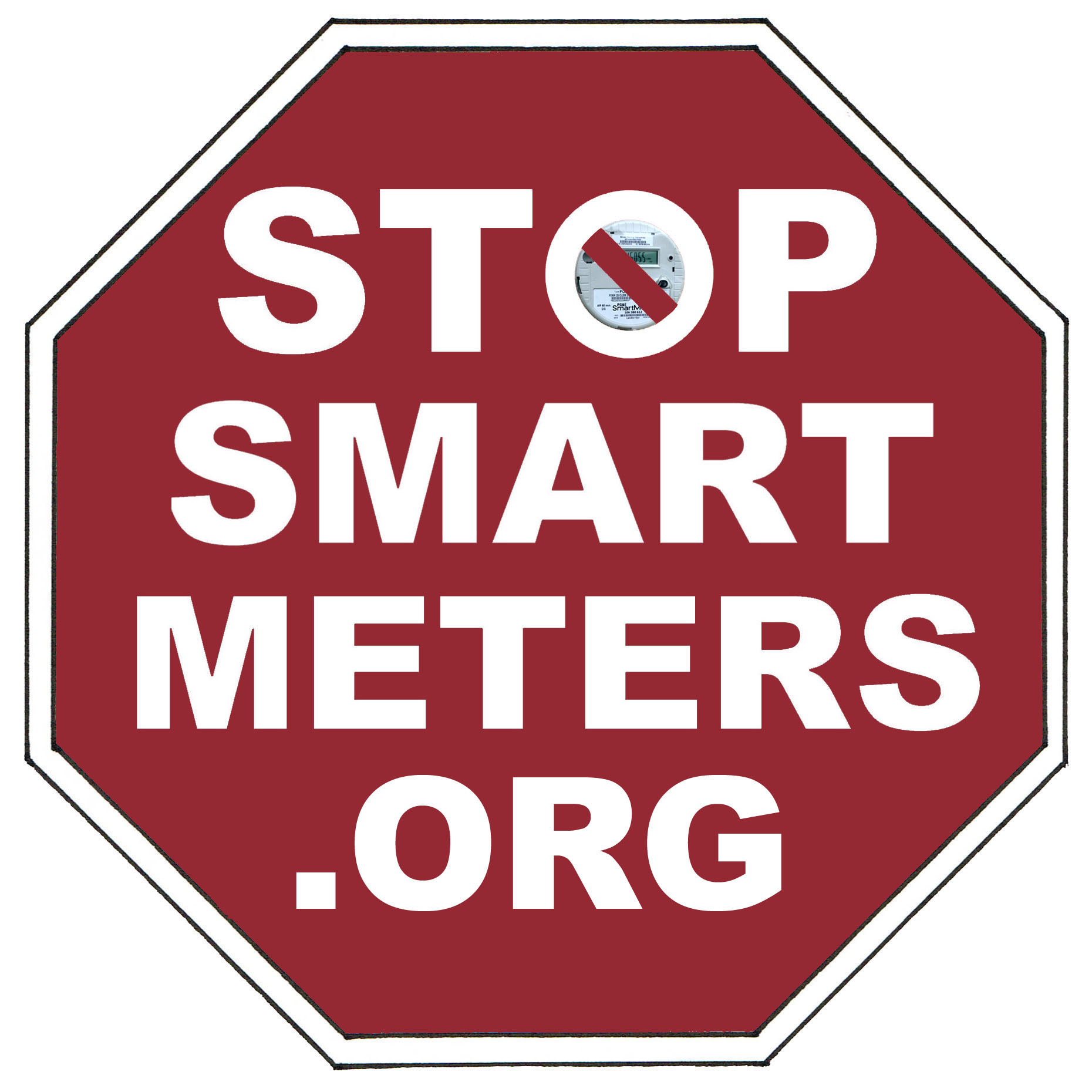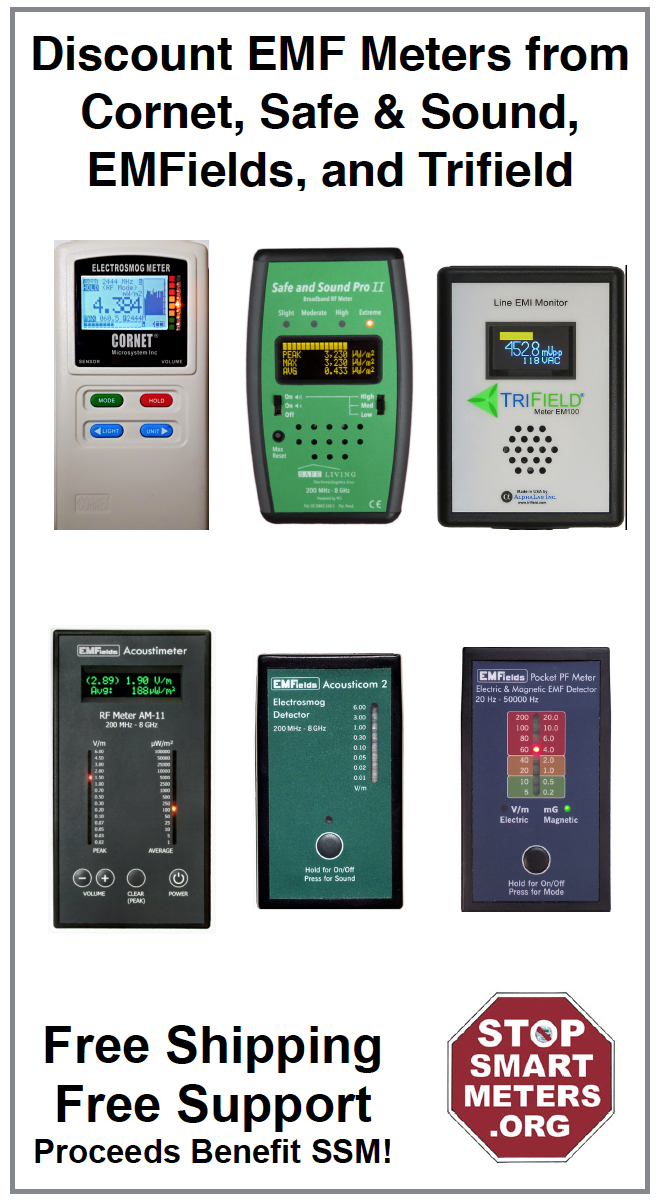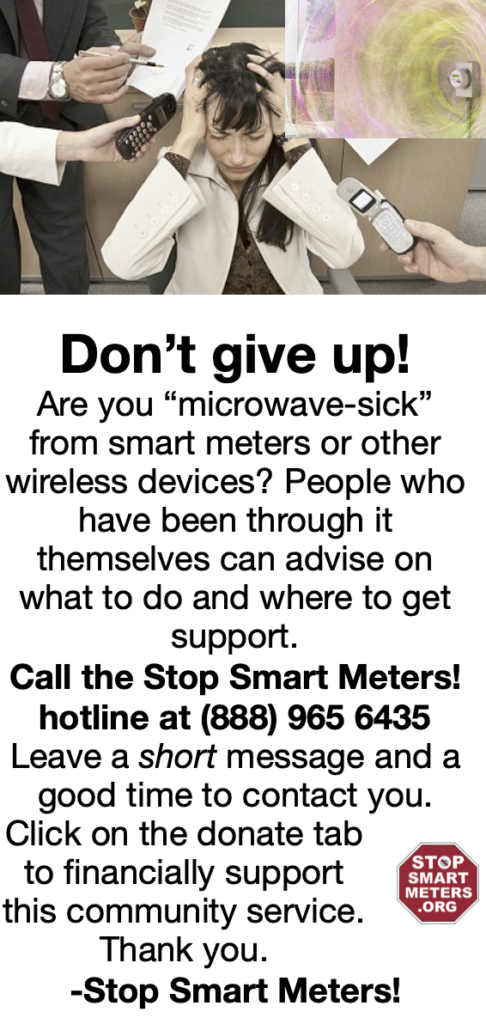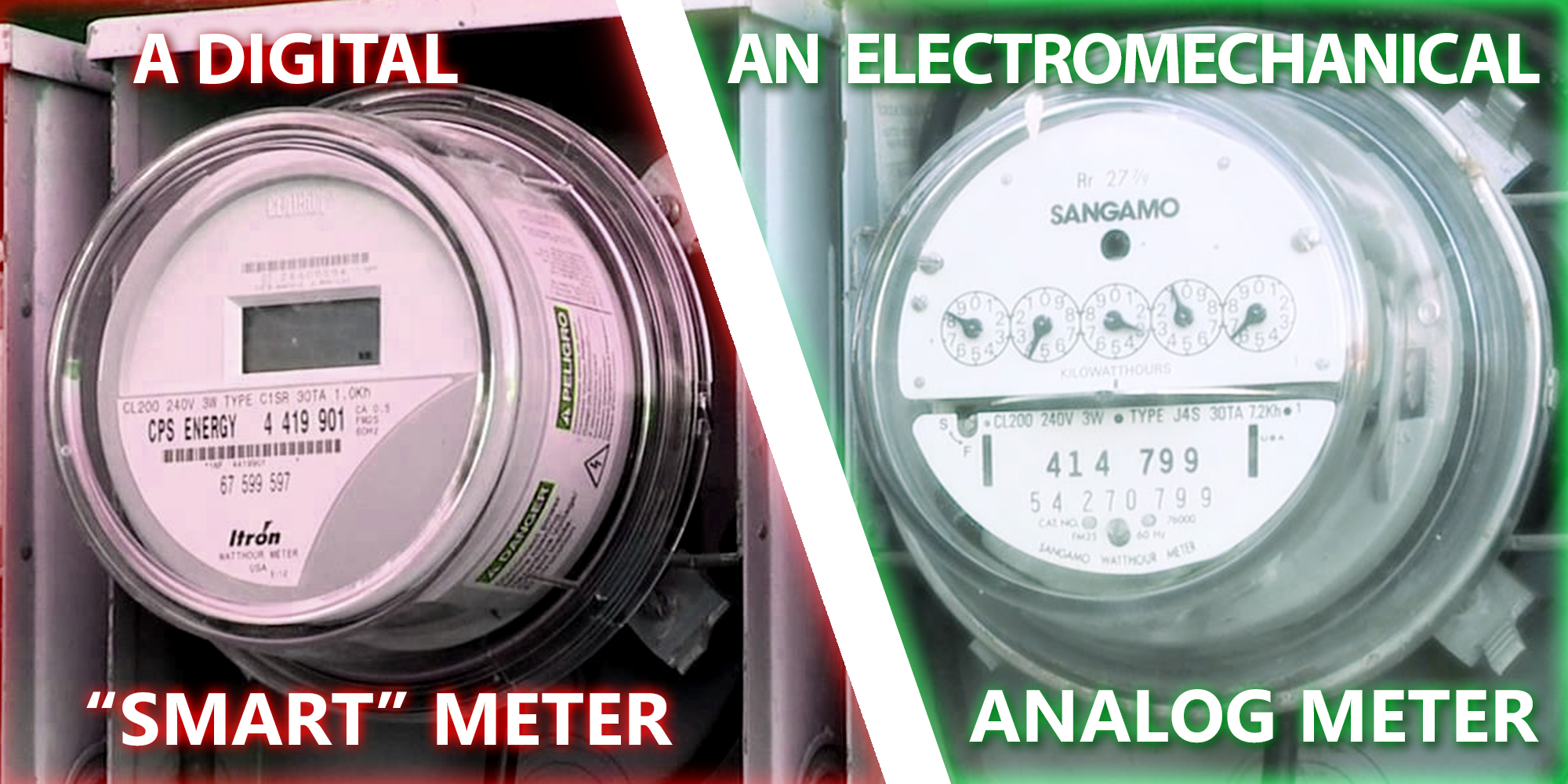A recent submission from a SSM! member, who didn’t believe PG&E’s claims that smart meter radiation is insignificant. The other day she went out into SF to do her own readings with an electromagnetic analyzer- what she found shocked her:
By Amy O’Hair
RF microwave radiation is invisible. It’s creepy to think about. No wonder many people would rather trust their government’s regulation of it than give it a second thought—or maybe just not think about it at all. PG&E tells me that RF radiation is everywhere in the modern world, so what can one more little emitter in my life matter?
I decided I wanted to know just how much there was around me, in this so-called RF-saturated urban world I live in. I got an instrument to measure the “power density” (in µW/m2) of radiation in the microwave range (from cell phones at 900 MHz to wifi at 2.4 GHz). I wanted to see the invisible.
I took readings around cell phone antennas, both small and large, cell phones themselves, the new wireless parking meters, wifi in cafes and libraries, my own microwave oven, and, of course, ‘smart’ meters in my neighborhood. I did this repeatedly. Things like cell phones and wifi fluctuate somewhat in radiation readings, but are fairly steady.
This is what I saw that alarmed me: ‘smart’ meters are very different, in that they emit extremely short, extremely sharp spikes of radiation, sometimes called pulses. I wouldn’t personally choose to stand in those other RF fields for long periods of time—but then none of them emit 24 hours a day, stuck to the side of my house, and none of them pulse high spikes like ‘smart’ meters do.
Some ‘smart’ meters pulse way more often than anything I’ve read about from PG&E. The radiation readings were so often I couldn’t count them, and so high I had to get an additional piece of equipment, an “attenuator,” to read how high the spikes went. Unfortunately, even with that extra equipment, I still couldn’t see the top of some spikes. Some spiked lower, some less often. But who knows what kind of emissions you will get when they install one in your home?
It has been an exciting few weeks. In numerous locations in San Francisco I’ve taken out this bit of equipment, and walked around taking readings. People come up to me to ask what I’m doing. It’s been great—I’ve never met so many strangers all at once. They are interested. Mostly, they don’t have much information about RF, and want to know a bit more. They often communicate to me a sense of helplessness and distrust of the corporate entities that hold so much power in their lives. (Of course I take the opportunity to talk about ‘smart’ meters…)
One woman came out of her house in Glen Park while I was measuring a “microcell” antenna, the tip of which was located about 15 feet from a bedroom wall. She’d watched it go up, and didn’t know who to call to say “No” to. What power did she have? Who was looking after the levels of radiation she and her family would be exposed to? (Happy note: I was able to tell her the antenna wasn’t yet turned on—there were no readings from it!)
I’ve also received mail via my YouTube site from people all over—helpless victims of ‘smart’ meter health effects. I can only write back to say how sorry I am to hear of their difficulties. Please, everyone, keep writing letters, keep speaking up, and keep educating your friends and neighbors—it matters!
Editors Note: You may have heard PG$E say things like:
“radio waves from a SmartMeter™, at a distance of 10 feet, are only about one one-thousandth as much as a typical cell phone.”
To arrive at this comparison, they use time-averaging and other sleight-of-hand techniques to obscure the powerful peak pulses from ‘smart’ meter devices. They also use inconsistent units of measurement on the same chart. In other words, bad and deceptive science. What matters here is peak power density, which our reader above, as well as other independent studies have demonstrated is well above other typical household exposures. Something like 100 times the full body exposure of using a cell phone, according to UC Nuclear Policy lecturer Dan Hirsch who kindly corrected the inaccurate figures published by the CCST. And utilities like PG$E are now approaching 90% installation of 10,000,000 meters in CA.
An unsolicited lab experiment indeed…









Excellent report, but I must add a few things.
The Landis+Gyr and GE electric meters normally transmit a 2 frequencies, the 916 MHz WAN network to transmit, receive and repeat billing data from other meters in the mesh network nearby, and they transmit at 2045 MHZ for the LAN ZigBee home area networks (HAN) that are not in use yet, and for some like me , they will never be used.
Since your field strength meter only went from 900 MHZ to 2400 MHZ, it did not measure the most powerful transmission of the collector meters, which is 825 MHz GSM to communicate with the cell phone towers. The power companies know who has collector meters, but they will never tell a customer if they have a collector meter. The collector meters take anywhere from 5 to 500 other meters data and repeat it to the cell network that is tied to the central controller. They put out at least 10 times the radiation as a regular smart meter.
Another thing to consider, even though a collector meter may only put out 1.17 watts of RF (not microwave), the cell repeaters themselves put out thousands of watts of RF to handle the multiple channels that they carry. I know first hand. I did a job for Nextel at The Tamalpais, the first highrise built in Marin back in the 60’s. My job was to run a new 200 amp 240 volt 3 phase service from one of the main panels up to the top floor where they were putting in a cell phone repeater for Nextel. That repeater uses a lot of electrical energy to put out thousands of watts of radio frequency energy.
A modern, standard FM broadcast station that transmits at 50,000 watts uses 75,000 watts of electrical energy to accomplish this . So it’s time that we start probing to see how much electrical energy will be required to power the 10 million new meters. Granted, maybe 3 or 4 million of the new meters in PG&E territory are gas meters, and they are completely separate and different from the electric meters that are plugged into the power grid. The gas meters are battery powered and only need to transmit usage data once a month.
The gas meters do not report outages or detect leaks, and there is still a flat rate for gas, so there is really no need for them at all, only to boost profits for PG&E by eliminating gas meter readers.
We need to start asking some hard questions, about how much energy the new electric meters consume, and we need more specific answers as to how they operate.
I don’t care if the information is proprietary, we have a right to know what we are refusing.
Personally, my opinion is that the power companies and the government are not telling us the truth at all. I think the electric meters use the house wiring as an antenna, and are putting RF into every ones homes.
I am in the process of researching the new smart meters contactor relays (the power switch). So far I have read different accounts about if they actually work here or not, and have not yet found the holding current required to keep the circuit closed (power on) at each meter. It will be interesting to find out how much energy is required to both operate the contactor and the transmitters.
I found some good info about how the system works, but it is put out by PG&E, so it has a corporate spin. Here is the link,
http://publicintelligence.net/confidential-pge-smartmeter-presentations/
The analyser I’m using detects emissions in frequencies between 800 MHz and 2.5 GHz, so that covers the collector you refer to as well. Do the collectors look different? Since I have measured some house-mounted SM that transmit much less often and at a lower power density, that suggests the meters in these videos are collectors.
The thing about house circuitry functioning as an antenna occurred to me. How would you test that? Could this antenna effect be dampened at the source?
The lack of information is outrageous. The days of Popular Electronics schematics are gone forever…
so i’m curious, is there something we can plug in to our outlets that will somehow mitigate or even disrupt these harmful frequencies??? from the smart meters or anything else that is using our wiring as an antenna.
First, get some knowledge of what “Microwave” means.
The microwave band starts at 3000 MHz, not 800 or 2400 MHz.
The statement “Another thing to consider, even though a collector meter may only put out 1.17 watts of RF (not microwave)” shows that someone needs more education. Microwave is “RF” (Radio Frequency). “Microwave” is a section of the non-ionizing RF band. RF is “RF” at 1 MHz and 18 GHz (18,000 MHz)
Then, get an industry standard and CALIBRATED power meter, and KNOW what you are measuring. Any power meter will measure any cumulative power within (and quite a ways outside) their published range.
Also, use a CALIBRATED UNITY-GAIN antenna. The antenna shown will amplify the signals at 2400 MHz by up to 20 dB, therefore, falsifying the readings.
Then, get a spectrum analyzer, which will tell you exact WHAT frequency you are measuring to confirm our “results”.
Cell towers do not transmit with “thousands of watts”. Power required mentioned above is largely for heating and Air Conditioning, powering the ancillary equipment (ATM switches, routers, digital access cross-connect systems, waveguide pressurization and dehydrator systems, et al) also, all cell sites have LARGE -48V DC battery back-up plants, that require high current chargers to recharge the battery plant quickly after long periods without AC power. These are typically 50-100A at 48VDC, which is typically 2500-5000 watts just for this purpose.
So… time to go back to the drawing board.
Bob, thanks for the clarification, I have always said that the smart meters do not operate at microwave frequencies, but do transmit radio frequencies (RF).
I find it very hard to believe that a cell phone tower would have a battery back up for air conditioners and dehumidifiers, are you sure about that ?
I know in remote areas that they use microwave repeaters for land line and mobile telephone trunk line service, but do you know if these cell towers in urban areas use land based trunk lines connected to the radio transmitters ?
I do know that all electronic devices use DC, they take AC and rectify it, but 100 amps @ 48 volts DC really packs a punch when being bit by it.
If a cell tower has a battery backup of 5000 watts , it could easily transmit 3000 watts of radio frequency. It depends on how busy the repeater is, but I would think most would put out 1000 watts of radio frequency at least.
When a cell phone accesses a repeater, the repeater senses the phone and adjusts the output on that channel as to how far away from the tower the phone is. Cell phones used to transmit at 600 miliwatts, but now most of the new cell phones only transmit at 200 miliwatts (2/10ths of a watt). The collector smart meters transmit at 1.17 watts in the 800 MHz GSM band to the cell towers, almost 6 times as powerful as a cell phone.
Sorry, my mistake, the collector meters actually put out more power, 1.51 watts @ 825 MHz. That is 7 and 1/2 times as powerful as a cell phone. And the cell towers transmit more power to reach each cell phone and the fixed collector meters.
The cell phones have special circuits to enhance the signals from the towers, and the towers then amplify and repeat those those thousands of channels of data and voice that they carry, every minute of the day and night.
A cell phone tower could easily put out 2000 watts of RF. Plus, those big microwave feed horns that communicate between the remote towers, put out even more power, in the microwave band. You would be fried if you got in line with one of those microwave horns.
@bob williams
Well, that’s debatable. Some put the lower limit of the microwave band at 1 GHz, which is barely above the .928 GHz that electricity ‘smart’ meters use. Some consider frequencies between 300 MHz (0.3 GHz) and 300 GHz to be included (wikipedia). My analyser detects a portion of that, 800 MHz to 2.5 GHz.
The analyser, even if it is off by some percentage or even a whole order of magnitude (though, other than your accusation, I don’t have evidence to suggest that), I have done so many readings that I certainly have a *context* of readings—I have stood near many sources of RF microwave radiation, and I have a large number of reference points.
Few people, even cell phone devotees, would choose to live next to a cell phone antenna. I have measured many antennas, and their peak densities do not come to within 2 orders of magnitude of the peak density of ‘smart’ meter pulses I have measured. That’s the point.
People with vastly more experience, training, and knowledge than me SHOULD BE DOING THIS WORK, not me. I would be pleased and happy to give it up, if anyone in my government or from a reputable independent research firm wants to take it over. Thrilled, in fact, absolutely thrilled.
In the mean time, I’ll go on doing this.
Hi Amy,
:lease don’t get discouraged, keep up the good work that you are doing !
I read that the Fairfax Town Council recently extended the moratorium on the new radio meters for another year, banning PG&E from installing any of their gear for the meters on all public streets and on public property. Also PG&E has stated that the 600 some smart meters that have been slapped in to the Town of Fairfax have allegedly-supposedly had their transmitters disabled.
If you could possibly find the time to go to Fairfax and put your field strength meter on a few new radio meters , that would be much appreciated. Look in the downtown area at businesses, I’m sure you can find a few.
Your field strength meter will do just fine, you don’t need a radio frequency counter like Bob says, we already know what frequencies are transmitted by the radio meters, we just need to know the power output (if any) in Fairfax.
Your meter probably displays radio transmitter power output in decibels times centimeter squared. There is a formula that you can use to convert those readings to power in watts .
It seems like you are interested in radio, so I have a great link that shows how the government allocates all the frequencies.
Note, you will need to click on the zoom tool, go to the 300MHz band and keep cilcking on the zoom tool until the text is readable, then scroll across the page to check out who is licensed or authorized to do what on the entire spectrum.
Here is the link:
http://ntia.doc.gov/osmhome/allochrt.pdf
i so wish you could come up to portland and do that! i and many others in heavy signal land don’t have enough $$$ to get any equipment at all.
Microwave starts below 3000MHz – and 2400-2485 MHz is the frequency for 802.11b microwave wifi, which is also the range of microwave ovens. The wavelength at 2400 MHz is 12.5 centimeters; “micro” of microwave does not mean “micro-meters”. For that you’d need to be at the frequency of visible light, about 470-650 Terahertz.
Then the only microwave frequency transmitted by the new meters is the 2045 MHz for the ZigBee home area networks system in the buildings. That system only transmits 0.0743 watts and uses 30 milliwatts of electricity to do so.
The frequencies transmitted by the new meters to connect with the other meters is 915 MHz, it is not microwave, and the collector meters that transmit the collected data to the cell towers is 850 HHz, transmitting at 1.51 watts of RF, again, not microwave.
People keep talking about the smart meters and microwave radiation, but really it is the 800 and 900 MHz transmissions that are more of a concern.
I wonder if the 900 MHz transmissions are interfering with the new emergency radio system in Marin (MERA).
I just read how MERA got more federal money to start using the 700 MHz band that was recently opened up due to television going digital . I wonder if the deployment of the new electric meters had anything to do with that federal grant ?.
I have read that the 900 MHz meters have caused interference on a town’s public radio system in Canada, and the town had to buy a new radio system for the Police, Fire and Public Works departments, and are considering suing Hydro 1, the power authority that is installing the new meters.
There have been complaints all over the world about radio transmitting electric meters interfering with radio communications. We have only scratched the surface of all the problems globally with this new program.
With enough lawsuits and the many other problems, hopefully the radio meter program will be squelched, and they will use BPL for transmitting, like they do in Italy and other parts of Europe, and like they originally were going to do here. Actually, some states are using their existing fiber optic plant using BPL instead of radio transmitted into the air for their billing system to eliminate meter readers jobs. That’s your federal stimulus money at work, eliminating jobs here in the U.S. and giving all these wireless technology corporations work that they have done by foreign labor making 10 cents per hour.
It sure made some people very rich who own these corporations that produce all this wireless garbage. But that money had to come from somewhere, it came from every consumer of electricity who has a new radio meter.
The stuff has just started to hit the fan, and like Major Hockstetter from Hogan’s heros has said many times,
HEADS VEEL RROOOLL !!
reply to Amy,
You could take your field strength meter inside someones house who has a smart meter and hold it on recepticals and also run it along the walls where wire is usually run. Check at about 3 feet off of the floor, that is where electricians usually drill holes in the studs, it is the most comfortable height for drilling with those big heavy Hole Hog drills.
The collector meters don’t look any different, and the power companies don’t want people who have the more powerful collector meters to know who has them.
I have been looking at various types of relays and contactors, especially solid state types that most likely would be in a smart meter. A smart meter for an average residential house would be able to handle at least 200 amps @240 volts, some larger houses have 400 amp services. The relays that I have found usually go up to 100 amps 3 phase @480 volts, typical for a large electric motor stater. All that I have seen are quite large, and it doesn’t look like they could fit a 200 amp relay into a smart meter. Another thing is that a switch that big has heat sinks, and I don’t see any evidence of heat sinks in a smart meter. I have also read accounts of people who listen the the power companies on the scanner radio to find out what is going on. They claim that the power companies are still dispatching technicians to pull meters on customers who fail to pay. So it is quite possible that this big feature of remote disconnect is just more propaganda from the power companies. The way that the power companies tell if there is a power interruption is that the data signal is dropped when the meter is off line.
This whole meter project has become the biggest fraud on electrical consumers and taxpayers in history. Hopefully it will be defrocked and exposed, then it will be just that, HISTORY !
Okay, if the only way with SMs the power co. can tell there is an outage is that the signal from a meter or meters is interrupted, they’ve got a strong incentive to make that signal very robust—they wouldn’t want to risk an accidental cut in the transmission (like, perhaps, a cell phone cuts out sometimes) because that would trigger a response re an outage unnecessarily. In essence, this “smart” device is quite blind.
I was talking yesterday with a fellow who’s developed a new antenna for cell phones to direct the RF away from the head, and he made the (now) obvious observation that it’s stupid to use a technology that is meant for mobility (needing omnidirectional transmission) on a device that is stationary. Directional antennas, mounted on the top of a structure and pointed at a receiver, wired to the meter(s), could have perhaps changed the issue of RF exposure levels.
Why couldn’t a simple rf ferrite choke be used between the SM and the household circuitry to keep RF from migrating in?
Most mobile phones are mobile, but it’s true the smart meters are stationary.
I have a Motorola i776 mobile phone that only works on Nextel’s iDEN network, it has an extendable antenna and a good quality speakerphone. That is why I bought it, because all the other mobile phones for all the other carriers have built in antennas, and the speakerphone is usually low quality.
What I always do is when using the mobile phone, I extent the antenna out and turn on the speakerphone and hold it at least 18 inches away from my body and always point the antenna away from me. This is safer than using a low powered smart phone holding it against the head. Unfortunately, Nextel has been bought by Sprint and they want to shut down the Nextel network in 2012, we will see about that, but if they do, I might give up and quit using a mobile phone.
The early mobile phones used to have a port for an external antenna, for when using it in a vehicle or at a fixed location with or without a 3 watt liner amplifier and a 3 watt speaker amplifier. When people use mobile phones in a vehicle or building without an external antenna, the signal is bouncing around inside, and if one uses a blue tooth car phone, you have yet another additional higher frequency bouncing around inside. I would never have a blue tooth anything.
I don’t know for a fact that the smart meters are using the house wiring as an antenna, but if they do, then installing a filter would be a very expensive job to put it inline between the meter and the main panel, and it would block the signals from the meter to the utility, initiating a trouble call.
Like I said, I don’t trust the power companies and the meter manufacturers to tell the public the real truth how they transmit, receive and repeat their data.
In some states they are using their existing fiber optic broadband, and in some countries they are using broadband power line carrier (BPL). That still transmits RF, but it is onto existing power lines, not into the air.
In Europe where they use BPL, but their grid is different than ours. In this country our grid uses aging ferrite core transformers and each step down transformer only serves 1 to 4 buildings. But in Europe, they have more modern solid state transformers that usually serve 10 buildings. The BPL signals can get through the electronic transformers , but these old ferrite core transformers in the U.S. don’t pass the BPL signal very well. Originally they were going to use BPL here, but changed their mind after finding that they would have to upgrade the power grid to solid state transformers for BPL to work here.
What the corporate heads have done was to cook up a way to fleece the taxpayers and ratepayers out of billions of dollars saying that it is to improve the power grid, and then turn around and spend all that money to automate the billing meters to eliminate meter reader jobs, and not improve the aging power grid at all.
This is the royal scam, they have spent millions of our taxpayers and ratepayers dollars on a propaganda campaign to brainwash the president and the public into thinking that somehow the new billing meters will save the customers energy and money, but actually the new meters only save the corporations money, and all these hundreds of millions of new meters will require massive amounts of electrical energy to operate, there by increasing the electrical load on the power grid, not reducing it like they falsely advertise. It is the corporations who are smart, not the meters.
Do you have your foil hat on?
@Senior Jones: Actually we find the chic numbers at http://www.handy-fashions.com/ to be much more to our liking. From the land where cell phones were invented, comes some good-looking ways to cut down the radiation going into your brain.
Once you know someone who has had to have a baseball-sized chunk of over-grown glial-cells dug out of their brain after a decade of cellphone use–and their family and future and whole life changed forever–you look upon the humble “tinfoil hat” a little differently, fool.
yes, in fact, i do….
My property (patio home all enclosed!) was invaded by CenterPoint Energy last week and they took my analog meter and installed a smart meter.
NOW WHAT????? What can I possibly do to get rid of it or protect myself from it now?
NO ONE in Texas is doing anything about this.
They did a Rapid Rollout in Texas, so as to avoid any negotiation or blockades. If I had had ANY idea this was going to happen last week I would have made a heavy wooden barricade ove my analog meter.
Do I have to move now? I am incensed, I am extremely angry about this.
I’m so sorry that Centerpoint got to your meter. We at BanSmartMeters.com are based in Texas. Check out the following page for contact info for a person in The Woodlands actively fighting Centerpoint. Good luck!
wait, you own a house in texas? so, why don’t you go all solar power , etc, and disconnect from the grid ???? lots of sun in texas. i think i would do it if it were me. get some kits.
I just discovered a smart meter outside of my home, already installed, after a friend called me today to say she had refused one from a Maine Central Power Company Employee. I don’t know how long it’s been there, but I do know it’s directly outside of the bedroom my 3 and 5 year old share. They have been recently waking up at night and vomitting, and then they will be absolutely fine throughout the day. At night and early morning, they start vomitting again. They have also been complaining about stomach and headaches. This may have nothing to do with the smart meter, but I find it a disturbing coincedence after doing a little online research about alleged health problems associated with RF emitters. We don’t own cell phones and I’m outraged that CMP was able to install something like this in my home without my prior knowledge or consent. I know it will be a pain in the ass to get them to take it off, if I can even get them to consider it.
Demand that CMP remove your ‘smart’ meter. Don’t take no for an answer. Seriously. You have a right to decide what goes on YOUR home. If necessary, call the media, go to their offices and sit in the doorway with a banner until they agree. Getting arrested is small potatoes compared with having one of these on your home. Or get an electrician to remove the meter if you can. Analog meters are sometimes available at electrical supply shops. Contact Maine Smart Meter Safety Coalition at http://smartmetersafety.com for more suggestions. If I was you and you tried all of the above, I would take a (wooden) baseball bat to the infernal device. Not worth the risk. CMP, SCE, PG&E and all the rest of these criminals couldn’t give a toss about your safety or health.
To happy mamajama: I would not spare a moment to get the children out of that room and into another as far away from the meter as possible, till the meter is gone. Document the sickness with the doctor and contact Maine smart meter group: http://www.smartmetersafety.com (Elisa Boxer) and file a complaint with the utility and Maine PUC, demand an immediate opt-out (which Maine is allowing, as I understand it). As a special ed teacher, I can tell you that you don’t want your kids exposed to something toxic to the neurological system. Lots of science on this topic at http://www.smartmeterdangers.org.
If the book is not highlighted on STOPSMARTMETERS.ORG then it should be, a new book by Devra Davis called “Disconnected”, I think, that is about the harm of EMF and discusses the coverups. It might as well have been written in direct support of the anti-smartmeter and anti-EMF folks, so do check it out (and ask Josh to highlight it on a side banner.)
Thanks for the advice! I called CMP and they were actually very cool about telling me they will remove it while they wait for a certain “ruling”. Hopefully they will do it soon, but I will keep calling if not. However, I read FCC documents this morning and various studies on dangerous types of non-ionizing radio waves and am not convinced smart meters fit the bill for the health issues we have. I will check out the sites mentioned here to become better informed.
We told the Edison company we did not want a smart meter on our home. The man wrote down something on his notepad, told us we would have to pay a ‘opt-out fee’ and that our electricity may be turned off if we didn’t. We told him OK and he left. Today we noticed Edison came when we weren’t home, went in our backyard, and installed the smart meter anyways. We’re having a baby this month and our house is quite small, I’m very worried about us all being exposed.
Did we calculate in the gain of that yagi antenna that’s attached to the meter? It has a lot of elements on it. Do we know the frequency range of that antenna?
Normally, if you were taking readings with a spectrum analyzer, you would just use a 1/4 wave dipole. With all the high tech going on in your area I don’t understand why some local RF guys haven’t jumped into this issue big time.
Just want to be accurate.
You may want to contact your local Amateur Radio club and see if people there would like to help out with the measurements.
FYI the smart meters use 900MHZ, which link up to some type of AP somewhere, probably an omni though we still havent confirmed. From there the data is transferred using 3.65 FCC licensed to some sort of main AP network and the data is collected there. You can check the FCC 3.65 license map and see where they are. I know this because im a network engineer for a WISP that uses 3.65 along with 900 and 2.4 canopy wireless.
Sorry if someone else mentioned this
Oh and as someone who works on this type of equipment on a daily basis including exposure at towers, i have yet to suffer any ill effects. I highly doubt the smart meters are causing as much issues as they are being said to. Now as for RF interference on our equipment, thats a whole different and frustrating story…
have my tin foil hat on, that is….